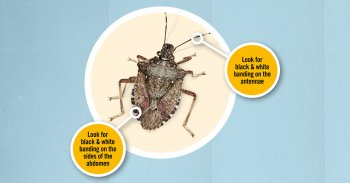
BMSB – Something Coming Your Way?
BMSB – Stands for ‘Brown Marmorated Stink Bug’.
What is it? – It seems to be a voracious version of our own ‘Stink Bug’, being much more destructive with a wide selection of hosts.
Where does it come from? – It is indigenous to some Asian countries but has found its way to and spread throughout North America. Now, it has also found its way to Europe and is again, spreading rapidly throughout Europe.
What are its Hosts? – Known hosts include the following: - Kiwifruit, Citrus, pipfruit, Tomatoes, Capsicum, Beetroot, Cucumber, Beans, Peas, Blueberries, Boysenberries, Feijoa, Persimmon, Tamarillo, Grapes, Summerfruit, Asparagus, Wheat, Corn, Raspberries, and varieties of ornamental trees and flowers.
The Nature and Threat of BMSB. - The risk to NZ horticultural industries is thought to be equal to, or greater than fruit fly. It has a large host range and its favourite overwintering place is in dark places around houses where it builds large populations. It is native in parts of Asia but has spread to the USA and now also Europe. Border interceptions of BMSB in 2015 were 22 and in 2016 there were 218, but it is suspected this was partly due to MPI ramping up their border inspections for BMSB.
It has been found to come in on – netting, tractors, orchard picking bags, mulch, trucks, compressors, etc, etc, even found in passengers’ luggage!
This is mostly from the USA and surveillance of items from USA has been ramped up. However due to its rapid spread throughout Europe the same precautions need to be taken for items coming from Europe. Second hand agricultural machinery is particularly susceptible.
The link below provides more information from HortNZ CEO Mike Chapman.
An OA [Operational Agreement] meeting has been initiated Under the GIA [Government Industry Agreement] legislation.
This means that – Product groups who are GIA signatories, and are affected by BMSB, will meet with MPI to work out how to deal with an incursion of BMSB. Subjects such as – potential impact of the pest; how decision making and governance of any activities will be undertaken; arrangements for negotiating market access; financial commitments, including cost-share, in kind contributions, fiscal caps and budgets; specific commitments; dispute settlements; and non signatory beneficiaries, including how to engage/consult and cost recover from them.
The initial meeting re a BMSB incursion was fully inclusive of all sectors potentially affected including NZFGA. The GIA signatories who will negotiate the ‘Operational Agreement’ are MPI, KVH, NZCGI, Tomatoes NZ, Pipfruit NZ and Vegetables NZ. Other affected groups participated as observers.
NZFGA made a report on that meeting as follows –
“Structure & cost Sharing.
All meeting participants agreed on the need for a BMSB Operational Agreement.
The establishment of a breeding population in NZ is the main threat and the cost of elimination is not known but thought to be expensive. If there were multiple breeding populations established it was thought that elimination would not be possible. Many interceptions are of one or two bugs and easily managed, theoretically two bugs can start a breeding population but it is not so likely especially as we are out of ‘sinc’ with their breeding season.
Due to the domestic threat – home gardens and orchards as well as house invasions - it was felt by many, that the industry/government split should be 100% to the government, but there was a lot of discussion around this and around ‘fiscal caps’ for industries. i.e. the limit to what an industry thought they could go in attempting eradicate a threat. One suggestion was that industry pay for all readiness operations, as well as eradication of one and two bug finds and government deal with any breeding populations.
If there were multiple breeding populations established the costs to Govt would be high and questions would be asked in parliament as to the effectiveness of the eradication attempts, so there is a fiscal cap for Govt also.
Already a readiness operation has been put into action with an application to EPA for the importation of a natural predator for the BMSB. This ‘BMSB Biocontrol Group’ was made up of representatives from MPI, HortNZ, KVH, Pipfruit, NZ Winegrowers, FAR and B3. DOC has concerns about these predators attacking native species if there are no BMSB’s to attack, so it will only ever be possible to establish a control population in a controlled environment. However it would be a step ahead to have population(s) of predators ready in case of a breeding population being established. The good news is that the natural predator [Samurai Wasp or Trissolcus japonicus] will reduce populations by about 75%.
Meeting participants agreed in principal that, where possible, beneficiary industry groups should contribute to the costs associated with the EPA application.
Outcome
Owing to the huge difficulties seen in assessing eradication costs and therefore how to apportion cost to various industries and government, it was decided to set up a BMSB Council as was done when the apportionment was done for the Fruit Fly. A sub group consisting of representatives from MPI, HortNZ, Pipfruit, NZ Winegrowers and the vegetable sector will further discuss the issues and then discuss them with MPI before coming back to the larger group”.
The first report from the sub group will be on 11th April 9am to 1pm. NZFGA will be attending as observers via a telephone link



 Classifieds
Classifieds



